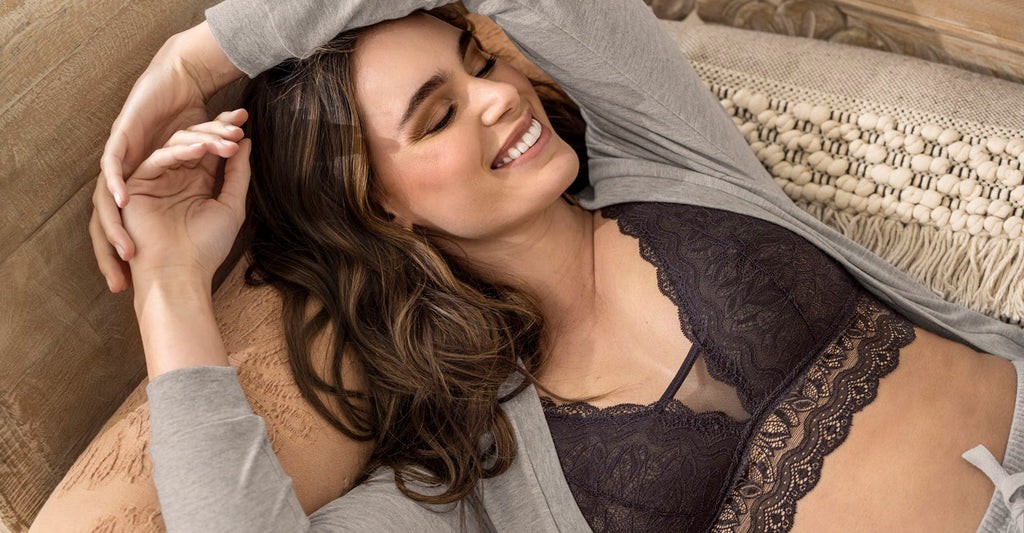Bralettes have surged in popularity, often displayed alongside traditional bras. The similar appearance and shared “bra” suffix can blur the lines between these garments. This guide clarifies the distinctions between a bralette vs. a bra, explores the hybrid option of wireless bras, and highlights the unique advantages of each, helping you choose the perfect fit for your needs.
Defining a Bralette
A bralette is essentially a bra without the traditional structure. It’s typically unlined or lightly lined and lacks underwire or significant padding. The band is usually crafted from stretchy elastic or lace, and the straps provide most of the minimal lift. Bralettes are often designed to be seen, featuring appealing colors, lace detailing, bows, and other stylish accents. They might have an adjustable band with hook-and-eye closures or a convenient pull-on style. Their comfort and stylish designs have fueled their increasing popularity. Bralettes are often sized from XS to 3XL or according to standard band-and-cup measurements, similar to regular bras.
Understanding the Traditional Bra
A bra is a supportive undergarment that features molded cups, underwire, and an adjustable band. Beyond lift and support, bras can also alter the appearance of the breasts, modifying their size and shape under clothing. Bras are available in various styles, including push-up, full coverage, balconette, demi cup, and longline. Unlined underwire bras are also an option, although many prefer padded styles for added comfort and wire cushioning. Bras range from plain t-shirt bras to more elaborate lingerie styles. Proper sizing, based on band and cup measurements, is crucial for ensuring the underwire is correctly proportioned to the breasts to prevent digging and discomfort.
Wireless Bras: Bridging the Gap
Wireless bras occupy a middle ground between bralettes and traditional bras. As the name implies, they lack underwire. However, wireless bras are distinct from bralettes. They are typically designed to be invisible under clothing, featuring solid neutral colors and smooth fabrics. Wireless bras often incorporate thicker padding and more structure than bralettes. A wireless bra can be seen as a t-shirt bra without the underwire. The cups are frequently molded to provide a more contoured silhouette, unlike the un-molded construction of bralettes.
The Allure of Bralettes: Key Benefits
If you’ve always worn traditional bras, you might wonder why you’d switch to bralettes. Here are some of the most popular reasons:
-
Minimal Padding: Bralettes can be unlined or very lightly lined, offering just enough coverage to prevent show-through. If the thicker padding of a regular bra feels excessive, a bralette might be an ideal choice.
-
Comfortable and Flexible: The absence of underwire and padding makes bralettes less rigid and structured than traditional bras. They adapt to your body’s shape and move with you throughout the day, minimizing chafing and maximizing comfort.
-
Stylish Designs and Materials: Bralettes are designed to be seen, making them more visually appealing than basic bras. They provide a stylish middle ground between the full coverage of everyday bras and the revealing nature of lingerie.
-
Versatile Wear: Some bralettes can double as crop tops, either worn alone or under an open jacket. This allows them to function as both underwear and outerwear, making them a versatile addition to your wardrobe.
The Enduring Appeal of Bras: Key Benefits
Before completely embracing bralettes, consider the unique advantages of traditional bras:
-
Reduced Strap Pressure: Traditional bras utilize a combination of a supportive band, structured cups, and underwire to provide lift, minimizing reliance on the straps. The band bears the weight, reducing strain on the shoulders, even if the straps slip. Bralettes, lacking this structure, can put more pressure on the shoulders over time.
-
Breast Shape Modification: Thanks to structured cups and padding, bras can alter the shape of the breasts under clothing, while bralettes primarily offer coverage without significant shape alteration.
-
Extensive Size Range: Finding a well-fitting bralette can be challenging for individuals with larger breasts or a small rib cage combined with a larger cup size. Bralettes often size the cups and bands together, which can be problematic if the rib cage is significantly smaller than the breasts. Traditional bras offer a more comprehensive range of sizes to accommodate diverse body types.
Choosing What’s Right for You: Bralette vs. Bra vs. Wireless Bra
Deciding between a bralette, a bra, or a wireless bra ultimately depends on personal comfort and preference. There’s no universal “right” choice.
Bralettes are often favored by women with smaller breasts who don’t require the structure and lift of an underwire bra. Conversely, women with larger breasts may prefer the support and reduced strap pressure offered by traditional bras. Given the wide variety of bralettes and bras available, generalizations can be misleading. Some bralettes may provide greater comfort for larger chests than certain underwire bras.
Wireless bras offer a compromise, providing more padding and structure than bralettes while eliminating underwire. However, for those with very large breasts, the stiffer fabric of wireless bras may buckle and crease uncomfortably. In such cases, the thinner fabric of bralettes, which conforms to the body without creating uncomfortable creases, might be a better option.
Ultimately, the best choice depends on your individual needs and preferences. Consider your breast size, desired level of support, and personal style when making your decision.

